Short-Term Impact of Tillage on Soil and the Hydrological Response within a Fig (Ficus Carica) Orchard in Croatia
Abstract
1. Introduction
2. Materials and Methods
2.1. Study Area, Climate, and Soil Properties
2.2. Experimental Design, Treatments, Sampling, and Rainfall Simulations
2.3. Laboratory Analyses
2.4. Data Analyses
3. Results
3.1. Rainfall Patterns
3.2. Topsoil Properties
3.3. Overland Flow Properties
3.4. Principal Component Analyses
4. Discussion
5. Conclusions
Author Contributions
Funding
Acknowledgments
Conflicts of Interest
Appendix A
| Factors | Eigenvalues of Correlation Matrix and Related Statistics | |||
|---|---|---|---|---|
| Eigenvalue | % Total | Cumulative | Cumulative | |
| 1 | 6.870559 | 49.07542 | 6.87056 | 49.0754 |
| 2 | 2.301528 | 16.43948 | 9.17209 | 65.5149 |
| 3 | 1.509930 | 10.78521 | 10.68202 | 76.3001 |
| 4 | 1.216229 | 8.68735 | 11.89825 | 84.9875 |
| 5 | 0.921799 | 6.58428 | 12.82004 | 91.5717 |
| 6 | 0.373413 | 2.66723 | 13.19346 | 94.2390 |
| 7 | 0.331562 | 2.36830 | 13.52502 | 96.6073 |
| 8 | 0.210259 | 1.50185 | 13.73528 | 98.1091 |
| 9 | 0.150673 | 1.07624 | 13.88595 | 99.1854 |
| 10 | 0.059838 | 0.42742 | 13.94579 | 99.6128 |
| 11 | 0.034298 | 0.24498 | 13.98009 | 99.8578 |
| 12 | 0.012329 | 0.08806 | 13.99242 | 99.9458 |
| 13 | 0.007493 | 0.05352 | 13.99991 | 99.9994 |
| 14 | 0.000091 | 0.00065 | 14.00000 | 100.0000 |
| Variable | Factor 1 | Factor 2 | Factor 3 | Factor 4 |
|---|---|---|---|---|
| BD (g cm−3) | −0.635970 | −0.106389 | −0.671890 | 0.289905 |
| WHC (%) | 0.645557 | −0.438237 | 0.297301 | 0.179958 |
| SWC (%) | −0.673038 | 0.265434 | −0.624049 | −0.025846 |
| MWD (mm) | −0.784366 | 0.275267 | −0.033961 | 0.425271 |
| WSA (%) | 0.457684 | 0.181181 | 0.000951 | 0.669754 |
| SOM (%) | 0.759445 | −0.310617 | −0.178819 | 0.323267 |
| P2O5 (mg kg-1) | 0.577460 | −0.398762 | −0.358618 | 0.272733 |
| PT (sec) | 0.736282 | −0.552068 | 0.038546 | 0.017696 |
| RT (sec) | 0.618064 | −0.496640 | −0.414612 | −0.148541 |
| WR (m3 ha−1) | −0.764620 | −0.216738 | 0.422021 | 0.351363 |
| SC (g kg-1) | −0.658483 | −0.618021 | −0.128423 | −0.232881 |
| SL (kg ha−1) | −0.832526 | −0.527928 | 0.056611 | −0.050388 |
| C loss (kg ha−1) | −0.826036 | −0.538793 | 0.069739 | −0.051622 |
| P loss (g ha−1) | −0.737336 | −0.338006 | 0.207075 | 0.292488 |
References
- Bordoni, M.; Vercesi, A.; Maeker, M.; Ganimede, C.; Reguzzi, M.C.; Capelli, E.; Wei, X.; Mazzoni, E.; Simoni, S.; Gagnarli, E.; et al. Effects of vineyard soil management on the characteristics of soils and roots in the lower Oltrepo Apennines (Lombardy, Italy). Sci. Total Environ. 2019, 693, 133390. [Google Scholar] [CrossRef]
- Pardini, A.; Faiello, C.; Longhi, F.; Mancuso, S.; Snowball, R. Cover crop species and their management in vineyards and olive groves. Adv. Hortic. Sci. 2002, 16, 225–234. [Google Scholar]
- Bogunovic, I.; Pereira, P.; Kisic, I.; Sajko, K.; Sraka, M. Tillage management impacts on soil compaction, erosion and crop yield in Stagnosols (Croatia). Catena 2018, 160, 376–384. [Google Scholar] [CrossRef]
- Al-Jabri, S.A.; Lee, J.; Gaur, A.; Horton, R.; Jaynes, D.B. A dripper-TDR method for in situ determination of hydraulic conductivity and chemical transport properties of surface soils. Adv. Water Resour. 2006, 29, 239–249. [Google Scholar] [CrossRef]
- Alletto, L.; Coquet, Y. Temporal and spatial variability of soil bulk density and near-saturated hydraulic conductivity under two contrasted tillage management systems. Geoderma 2009, 152, 85–94. [Google Scholar] [CrossRef]
- Blavet, D.; De Noni, G.; Le Bissonnais, Y.; Leonard, M.; Maillo, L.; Laurent, J.Y.; Asseline, J.; Leprun, J.C.; Arshad, M.A.; Roose, E. Effect of land use and management on the early stages of soil water erosion in French Mediterranean vineyards. Soil Till. Res. 2009, 106, 124–136. [Google Scholar] [CrossRef]
- Heshmati, M.; Arifin, A.; Shamshuddin, J.; Majid, N.M. Predicting N, P, K and organic carbon depletion in soils using MPSIAC model at the Merek catchment, Iran. Geoderma 2012, 175–176, 64–77. [Google Scholar] [CrossRef]
- Navas, A.; Gaspar, L.; Quijano, L.; Lopez-Vicente, M.; Machin, J. Patterns of soil organic carbon and nitrogen in relation to soil movement under different land uses in mountain fields (South Central Pyrenees). Catena 2012, 94, 43–52. [Google Scholar] [CrossRef]
- Zhang, C.; Liu, G.B.; Xue, S.; Sun, C.L. Soil organic carbon and total nitrogen storage as affected by land use in a small watershed of the Loess Plateau, China. Eur. J. Soil Biol. 2013, 54, 16–24. [Google Scholar] [CrossRef]
- Niu, X.Y.; Wang, Y.H.; Yang, H.; Zheng, J.W.; Zou, J.; Xu, M.N.; Wu, S.S.; Xie, B. Effect of Land Use on Soil Erosion and Nutrients in Dianchi Lake Watershed, China. Pedosphere 2015, 25, 103–111. [Google Scholar] [CrossRef]
- Ferreira, C.S.S.; Keizer, J.J.; Santos, L.M.B.; Serpa, D.; Silva, V.; Cerqueira, M.; Ferreira, A.J.D.; Abrantes, N. Runoff, sediment and nutrient exports from a Mediterranean vineyard under integrated production: An experiment at plot scale. Agric. Ecosyst. Environ. 2018, 256, 184–193. [Google Scholar] [CrossRef]
- Blair, N.; Faulkner, R.D.; Till, A.R.; Korschens, M.; Schulz, E. Long-term management impacts on soil C, N and physical fertility: Part I: Broad balk experiment. Soil Till. Res. 2006, 91, 30–38. [Google Scholar] [CrossRef]
- La Scala, N.; Bolonhezi, D.; Pereira, G.T. Short-term soil CO2 emission after conventional and reduced tillage of a no-till sugar cane area in southern Brazil. Soil Till. Res. 2006, 91, 244–248. [Google Scholar] [CrossRef]
- Bogunovic, I.; Andabaka, Z.; Stupic, D.; Pereira, P.; Galic, M.; Novak, K.; Telak, L.J. Continuous grass coverage as a management practice in humid environment vineyards increases compaction and CO2 emissions but does not modify must quality. Land Degrad Dev. 2019, 30, 2347–2359. [Google Scholar] [CrossRef]
- Kibet, K.C.; Blanco-Canqui, H.; Jasa, P. Long-term tillage impacts on soil organic matter components and related properties on a Typic Argiudoll. Soil Till. Res. 2016, 155, 78–84. [Google Scholar] [CrossRef]
- Yeboah, S.; Zhang, R.; Cai, L.; Li, L.; Xie, J.; Luo, Z.; Liu, J.; Wu, J. Tillage effect on soil organic carbon, microbial biomass carbon and crop yield in spring wheat-field pea rotation. Plant Environ. 2016, 6, 279–285. [Google Scholar] [CrossRef]
- Bartos, A.; Szymański, W.; Klimek, M. Impact of conventional agriculture on the concentration and quality of water-extractable organic matter (WEOM) in the surface horizons of Retisols—A case study from the Carpathian Foothills in Poland. Soil Till. Res. 2020, 204, 104750. [Google Scholar] [CrossRef]
- Margenot, A.J.; Paul, B.K.; Sommer, R.R.; Pulleman, M.M.; Parikh, S.S.; Jackson, L.E.; Fonte, S.J. Can conservation agriculture improve phosphorus (P) availability in weathered soils? Effects of tillage and residue management on soil P status after 9 years in a Kenyan Oxisol. Soil Till. Res. 2017, 166, 157–166. [Google Scholar] [CrossRef]
- Xiao, S.S.; Ye, Y.Y.; Xiao, D.; Zhang, W.; Wang, K.L. Effects of tillage on soil N availability, aggregate size, and microbial biomass in a subtropical karst region. Soil Till. Res. 2019, 192, 187–195. [Google Scholar] [CrossRef]
- Bongiorno, G.; Bünemann, E.K.; Oguejiofor, C.U.; Meier, J.; Gort, G.; Comans, R.; Mader, P.; Brussaard, L.; de Goede, R. Sensitivity of labile carbon fractions to tillage and organic matter management and their potential as comprehensive soil quality indicators across pedoclimatic conditions in Europe. Ecol Indic. 2019, 99, 38–50. [Google Scholar] [CrossRef]
- Bronick, C.J.; Lal, R. Soil structure and management: A review. Geoderma 2005, 124, 3–22. [Google Scholar] [CrossRef]
- Chan, K.Y.; Heenan, D.P.; Ashley, R. Seasonal changes in surface aggregate stability under different tillage and crops. Soil Till. Res. 1994, 28, 301–314. [Google Scholar] [CrossRef]
- Horton, R.; Ankeny, M.D.; Allmaras, R.R. Effects of compaction on soil hydraulic properties. In Soil Compaction in Crop Production; Soane, B.D., van Ouwerkerk, C., Eds.; Elsevier: Amsterdam, The Netherlands, 1994; pp. 141–165. [Google Scholar]
- Dec, D.; Dörner, J.; Becker-Fazekas, O.; Horn, R. Effect of bulk density on hydraulic properties of homogenized and structured soils. J. Soil Sci. Plant Nutr. 2008, 8, 1–13. [Google Scholar]
- Strudley, W.M.; Green, T.R.; Ascough, J.C., II. Tillage effects on soil hydraulic properties in space and time: State of the science. Soil Till. Res. 2008, 99, 4–48. [Google Scholar] [CrossRef]
- Jirků, V.; Kodešová, R.; Nikodem, A.; Mühlhanselová, M.; Žigová, A. Temporal variability of structure and hydraulic properties of topsoil of three soil types. Geoderma 2013, 204, 43–58. [Google Scholar] [CrossRef]
- Kool, D.; Tong, B.; Tian, Z.; Heitman, J.L.; Sauer, T.J.; Horton, R. Soil water retention and hydraulic conductivity dynamics following tillage. Soil Till. Res. 2019, 193, 95–100. [Google Scholar] [CrossRef]
- Keller, T.; Colombi, T.; Ruiz, S.; Manalili, M.P.; Rek, J.; Stadelmann, V.; Wunderli, H.; Breitenstein, D.; Reiser, R.; Oberholzer, H.; et al. Long-term soil structure observatory for monitoring post-compaction evolution of soil structure. Vadose Zone J. 2017, 16, 1–16. [Google Scholar] [CrossRef]
- Chandrasekhar, P.; Kreiselmeier, J.; Schwen, A.; Weninger, T.; Julich, S.; Feger, K.H.; Schwarel, K. Modeling the evolution of soil structural pore space in agricultural soils following tillage. Geoderma 2019, 353, 401–414. [Google Scholar] [CrossRef]
- Birkas, M.; Szemők, A.; Antos, G.; Neményi, M. Environmentally-Sound Adaptable Tillage; Akadémiai Kiadó: Budapest, Hungary, 2008. [Google Scholar]
- Biddoccu, M.; Ferraris, S.; Pitacco, A.; Cavallo, E. Temporal variability of soil management effects on soil hydrological properties, runoff and erosion at the field scale in a hillslope vineyard, North-West Italy. Soil Till. Res. 2017, 165, 46–48. [Google Scholar] [CrossRef]
- Rodrigo-Comino, J.; Novara, A.; Gyasi-Agyei, Y.; Terol, E.; Cerda, A. Effects of parent material on soil erosion within Mediterranean new vineyard plantations. Eng. Geol. 2018, 246, 255–261. [Google Scholar] [CrossRef]
- Ouyang, W.; Wu, Y.; Hao, Z.; Zhang, Q.; Bu, Q.; Gao, X. Combined impacts of land use and soil property changes on soil erosion in a mollisol area under long-term agricultural development. Sci. Total Environ. 2018, 613, 298–809. [Google Scholar] [CrossRef] [PubMed]
- Bogunovic, I.; Telak, L.J.; Pereira, P. Agriculture management impacts on soil properties and hydrological response in Istria (Croatia). Agronomy 2020, 10, 282. [Google Scholar]
- Kisic, I.; Bogunovic, I.; Birkás, M.; Jurisic, A.; Spalevic, V. The role of tillage and crops on a soil loss of an arable Stagnic Luvisol. Arch. Agron. Soil Sci. 2017, 63, 403–413. [Google Scholar] [CrossRef]
- Rodrigo-Comino, J. Five decades of soil erosion research in “terroir”. The State-of-the-Art. Earth-Sci. Rev. 2018, 179, 436–447. [Google Scholar] [CrossRef]
- Gómez, J.A.; Sobrinho, T.A.; Giráldez, J.V.; Fereres, E. Soil management effects on runoff, erosion and soil properties in an olive grove of Southern Spain. Soil Till. Res. 2009, 102, 5–13. [Google Scholar] [CrossRef]
- Rodrigo-Comino, J.; Giménez-Morera, A.; Panagos, P.; Pourghasemi, H.R.; Pulido, M.; Cerdà, A. The potential of straw mulch as a nature-based solution for soil erosion in olive plantation treated with glyphosate: A biophysical and socioeconomic assessment. Land Degrad. Develop. 2019, 31, 1877–1889. [Google Scholar] [CrossRef]
- Atucha, A.; Merwin, I.A.; Brown, M.G.; Gardiazabal, F.; Mena, F.; Adriazola, C.; Lehmann, J. Soil erosion, runoff and nutrient losses in an avocado (Persea americana Mill) hillside orchard under different groundcover management systems. Plant Soil 2013, 368, 393–406. [Google Scholar] [CrossRef]
- Li, X.H.; Yang, J.; Zhao, C.Y.; Wang, B. Runoff and sediment from orchard terraces in south-eastern China. Land Degrad. Develop. 2014, 25, 184–192. [Google Scholar] [CrossRef]
- Marzolff, I.; Ries, J.B.; Poesen, J. Short-term versus medium-term monitoring for detecting gully-erosion variability in a Mediterranean environment. Earth Surf. Process. Landf. 2011, 36, 1604–1623. [Google Scholar] [CrossRef]
- Da Silva, A.M.; Moradi, E.; Rodrigo-Comino, J.; Cerdà, A. Spatial variability of soil roughness in persimmon plantations: A new combined ISUM (improved stock unearthing method) approach. Ecol. Indic. 2019, 106, 105528. [Google Scholar] [CrossRef]
- Sanchez, L.A.; Ataroff, M.; Lopez, R. Soil erosion under different vegetation covers in the Venezuelan Andes. Environmentalist 2002, 22, 161–172. [Google Scholar] [CrossRef]
- Abrisqueta, J.M.; Plana, V.; Mounzer, O.H.; Mendez, J.; Ruiz-Sanchez, M.C. Effects of soil tillage on runoff generation in a Mediterranean apricot orchard. Agric. Water Manag. 2007, 93, 11–18. [Google Scholar] [CrossRef]
- Veberic, R.; Colaric, M.; Stampar, F. Phenolic acids and flavonoids of fig fruit (Ficus carica L.) in the northern Mediterranean region. Food Chem. 2008, 16, 153–157. [Google Scholar] [CrossRef]
- Pereira, C.; Serradilla, M.J.; Pérez-Gragera, F.; Martín, A.; Villalobos, M.C.; López-Corrales, M. Evaluation of agronomic and fruit quality traits of fig tree varieties (Ficus carica L.) grown in Mediterranean conditions. Span. J. Agric. Res. 2017, 15, e0903. [Google Scholar] [CrossRef]
- Croatian Meteorological and Hydrological Service. Available online: https://meteo.hr/index_en.php (accessed on 21 May 2020).
- IUSS Working Group WRB. World Reference Base for Soil Resources 2014, Update 2015: International Soil Classification System for Naming Soils and Creating Legends for Soil Maps; World Soil Resources Reports No. 106, 192; IUSS: Vienna, Austria, 2015. [Google Scholar]
- Casanova, M.; Tapia, E.; Seguel, O.; Salazar, O. Direct measurement and prediction of bulk density on alluvial soils of central Chile. Chilean J. Agric. Res. 2016, 76, 105–113. [Google Scholar] [CrossRef]
- Diaz-Zorita, M.; Perfect, E.; Grove, J.H. Disruptive methods for assessing soil structure. Soil Till. Res. 2002, 64, 3–22. [Google Scholar] [CrossRef]
- Le Bissonnais, Y. Aggregate stability and assessment of soil crustability and erodibility: Theory and methodology. Eur. J. Soil Sci. 1996, 47, 425–437. [Google Scholar] [CrossRef]
- Kemper, W.D.; Rosenau, R.C. Aggregate Stability and Size Distribution, Methods of Soil Analysis; Klute, A., Ed.; Soil Science Society of America: Madison, WI, USA, 1986; pp. 425–442. [Google Scholar]
- Walkley, A.J.; Black, I.A. Estimation of soil organic carbon by the chromic acid titration method. Soil Sci. 1934, 37, 29–38. [Google Scholar] [CrossRef]
- Egner, H.; Riehm, H.; Domingo, W.R. Untersuchungen über die chemische Bodenanalyse als Grundlage für die Beurteilung des Nahrstoffzustandes der Boden, II. Chem. Extr. Metod. Phosphorund Kaliumbestimmung K. Lantbr. Ann. 1960, 26, 199–215. [Google Scholar]
- Plotly. Chart Studio. Available online: https://chart-studio.plotly.com (accessed on 9 May 2020).
- Osunbitan, J.A.; Oyedele, D.J.; Adekalu, K.O. Tillage effects on bulk density, hydraulic conductivity and strength of a loamy sand soil in southwestern Nigeria. Soil Till. Res. 2005, 82, 57–64. [Google Scholar] [CrossRef]
- Mubarak, I.; Mailhol, J.C.; Angulo-Jaramillo, R.; Ruelle, P.; Boivin, P.; Khaledian, M. Temporal variability in soil hydraulic properties under drip irrigation. Geoderma 2009, 150, 158–165. [Google Scholar] [CrossRef]
- Tian, Z.; Gao, W.; Kool, D.; Ren, T.; Horton, R.; Heitman, J.L. Approaches for estimating soil water retention curves at various bulk densities with the extended van Genuchten model. Water Resour. Res. 2018, 54, 5584–5601. [Google Scholar] [CrossRef]
- Busscher, W.J.; Bauer, P.J.; Frederick, J.R. Recompaction of a coastal loamy sand after deep tillage as a function of subsequent cumulative rainfall. Soil Till. Res. 2002, 68, 49–57. [Google Scholar] [CrossRef]
- Heikkinen, J.; Keskinen, R.; Soinne, H.; Hyväluoma, J.; Nikama, J.; Wikberg, H.; Källi, A.; Siipola, V.; Melkior, T.; Dupont, C.; et al. Possibilities to improve soil aggregate stability using biochars derived from various biomasses through slow pyrolysis, hydrothermal carbonization, or torrefaction. Geoderma 2019, 344, 40–49. [Google Scholar] [CrossRef]
- Calderón, F.J.; Jackson, L.E.; Scow, K.M.; Rolston, D.E. Microbial responses to simulated tillage in cultivated and uncultivated soils. Soil Biol. Biochem. 2000, 32, 1547–1559. [Google Scholar] [CrossRef]
- Lal, R. Carbon Sequestration, Terrestrial. In Reference Module in Earth Systems and Environmental Sciences; Elsevier: Amsterdam, The Netherlands, 2013; Volume 1, pp. 289–298. [Google Scholar]
- Yang, F.; Zhang, G.L.; Yang, J.L.; Li, D.C.; Zhao, Y.G.; Liu, F.; Yang, R.M.; Yang, F. Organic matter controls of soil water retention in an alpine grassland and its significance for hydrological processes. J. Hydrol. 2014, 519, 3086–3093. [Google Scholar] [CrossRef]
- Zhao, J.; Chen, S.; Hu, R.; Li, Y. Aggregate stability and size distribution of red soils under different land uses integrally regulated by soil organic matter, and iron and aluminium oxides. Soil Till. Res. 2017, 167, 73–79. [Google Scholar] [CrossRef]
- Šimansky, V.; Juriga, M.; Jonczak, J.; Uzarowicz, L.; Stepien, W. How relationships between soil organic matter parameters and soil structure characteristics are affected by the long-term fertilization of a sandy soil. Geoderma 2019, 342, 75–84. [Google Scholar] [CrossRef]
- Peng, X.; Yan, X.; Zhou, H.; Zhang, Y.Z.; Sun, H. Assessing the contributions of sesquioxides and soil organic matter to aggregation in an Ultisol under long-term fertilization. Soil Till. Res. 2014, 146, 89–98. [Google Scholar] [CrossRef]
- Yu, Z.; Zhang, J.; Zhang, C.; Xin, X.; Li, H. The coupling effects of soil organic matter and particle interaction forces on soil aggregate stability. Soil Till. Res. 2017, 174, 251–260. [Google Scholar] [CrossRef]
- Wuddivira, M.N.; Camps-Roach, G. Effects of organic matter and calcium on soil structural stability. Eur. J. Soil Sci. 2006, 58, 722–727. [Google Scholar] [CrossRef]
- Assouline, S.; Selker, J.S.; Parlange, J.Y. A simple accurate method to predict time of ponding under variable intensity rainfall. Water Resour. Res. 2007, 43. Available online: https://agupubs.onlinelibrary.wiley.com/doi/10.1029/2006WR005138 (accessed on 20 November 2020). [CrossRef]
- Mu, H.; Yu, X.; Fu, S.; Yu, B.; Liu, Y.; Zhang, G. Effect of stem basal cover on the sediment transport capacity of overland flows. Geoderma 2019, 337, 384–393. [Google Scholar] [CrossRef]
- Nicosia, A.; Di Stefano, C.; Palmeri, V.; Pampalone, V.; Ferro, V. Flow resistance of overland flow on a smooth bed under simulated rainfall. Catena 2020, 187, 104351. [Google Scholar] [CrossRef]
- Ribolzi, O.; Evrard, O.; Huon, S.; de Rouw, A.; Silvera, N.; Latsachack, O.; Soulileuth, B.; Lefèvre, I.; Pierret, A.; Lacombe, G.; et al. From shifting cultivation to teak plantation: Effect on overland flow and sediment yield in a montane tropical catchment. Sci. Rep. 2017, 7, 3987. [Google Scholar] [CrossRef] [PubMed]
- Lacombe, G.; Valentin, C.; Sounyafong, P.; de Rouw, A.; Soulileuth, B.; Silvera, N.; Pierret, A.; Sengtaheuanghoung, O.; Ribolzi, O. Linking crop structure, throughfall, soil surface conditions, runoff and soil detachment: 10 land uses analyzed in Northern Laos. Sci. Total Environ. 2018, 616, 1330–1338. [Google Scholar] [CrossRef]
- Sadeghi, S.H.; Harchegani, M.K.; Asadi, H. Variability of particle size distributions of upward/downward splashed materials in different rainfall intensities and slopes. Geoderma 2017, 290, 100–106. [Google Scholar] [CrossRef]
- Shiedung, H.; Bornemann, L.; Welp, G. Seasonal Variability of Soil Organic Carbon Fractions Under Arable Land. Pedosphere 2017, 27, 380–386. [Google Scholar] [CrossRef]
- Zumr, D.; Jeřábek, J.; Klípa, V.; Dohnal, M.; Sněhota, M. Estimates of Tillage and Rainfall Effects on Unsaturated Hydraulic Conductivity in a Small Central European Agricultural Catchment. Water 2019, 11, 740. [Google Scholar] [CrossRef]
- Verheijen, F.G.A.; Jones, R.J.A.; Rickson, R.J.; Smith, C.J.; Bastos, A.C.; Nunes, J.P.; Keizer, J.J. Concise overview of European soil erosion research and evaluation. Acta Agric. Scand. B 2012, 62, 185–190. [Google Scholar] [CrossRef]
- Meinen, B.U.; Robinson, D.T. Where did the soil go? Quantifying one year of soil erosion on a steep tile-drained agricultural field. Sci. Total Environ. 2020, 729, 138320. [Google Scholar] [CrossRef] [PubMed]
- Pereira, P.; Barcelo, D.; Panagos, P. Soil and water threats in a changing environment. Environ. Res. 2020, 186, 109501. [Google Scholar] [CrossRef] [PubMed]
- Shabnam, R.; Hasan Tarek, M.; Toufiq Iqbal, M. Understanding phosphorus dynamics in wheat plant and growth response in a split-root system in acidic soil. Agric. Nat. Resour. 2018, 52, 259–265. [Google Scholar] [CrossRef]
- Li, F.R.; Liu, L.L.; Liu, J.L.; Yang, Y. Abiotic and biotic controls on dynamics of labile phosphorus fractions in calcareous soils under agricultural cultivation. Sci. Total Environ. 2019, 81, 163–174. [Google Scholar] [CrossRef]
- Komissarov, M.; Ogura, S.I. Siltation and radiocesium pollution of small lakes in different catchment types far from the Fukushima Daiichi nuclear power plant accident site. Int. Soil Water Conserv. Res. 2020, 8, 56–65. [Google Scholar] [CrossRef]
- Ulrich, A.E.; Malley, D.F.; Watts, P.D. Lake Winnipeg Basin: Advocacy, challenges and progress for sustainable phosphorus and eutrophication control. Sci. Total Environ. 2016, 542, 1030–1039. [Google Scholar] [CrossRef]
- Pereira, P.; Bogunovic, I.; Munoz-Rojas, M.; Brevik, E. Soil ecosystem services, sustainability, valuation and management. Curr. Opin. Environ. Sci. Health 2018, 5, 7–13. [Google Scholar] [CrossRef]
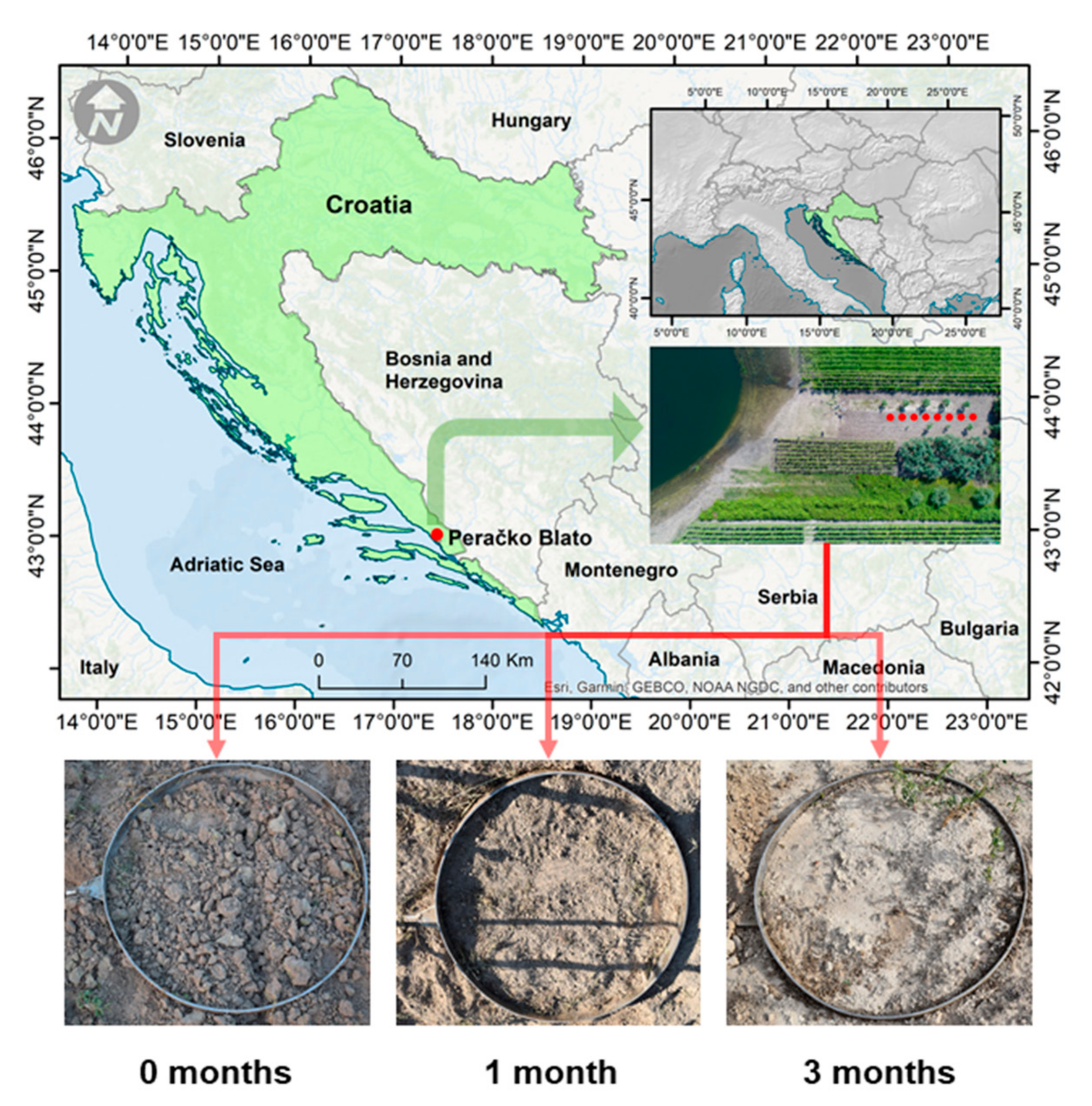
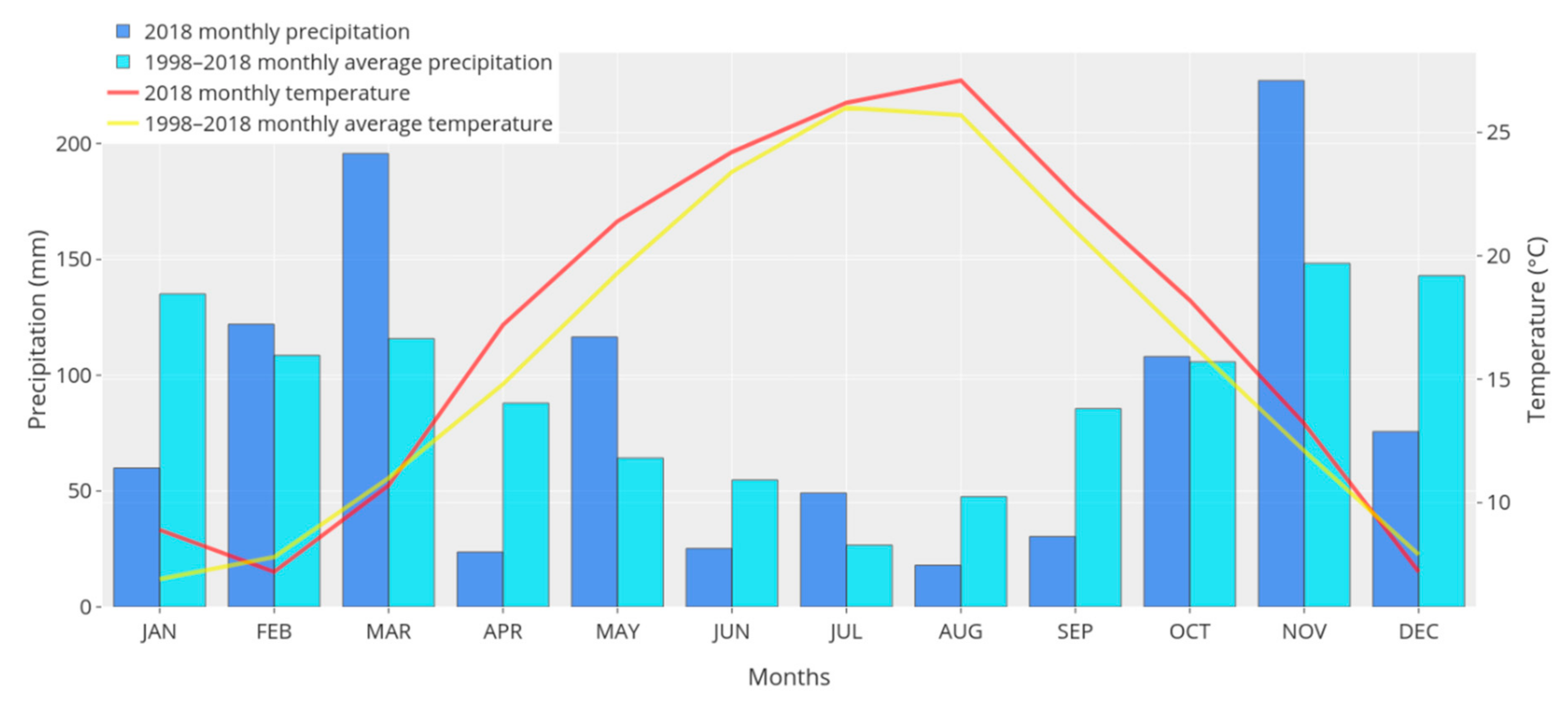
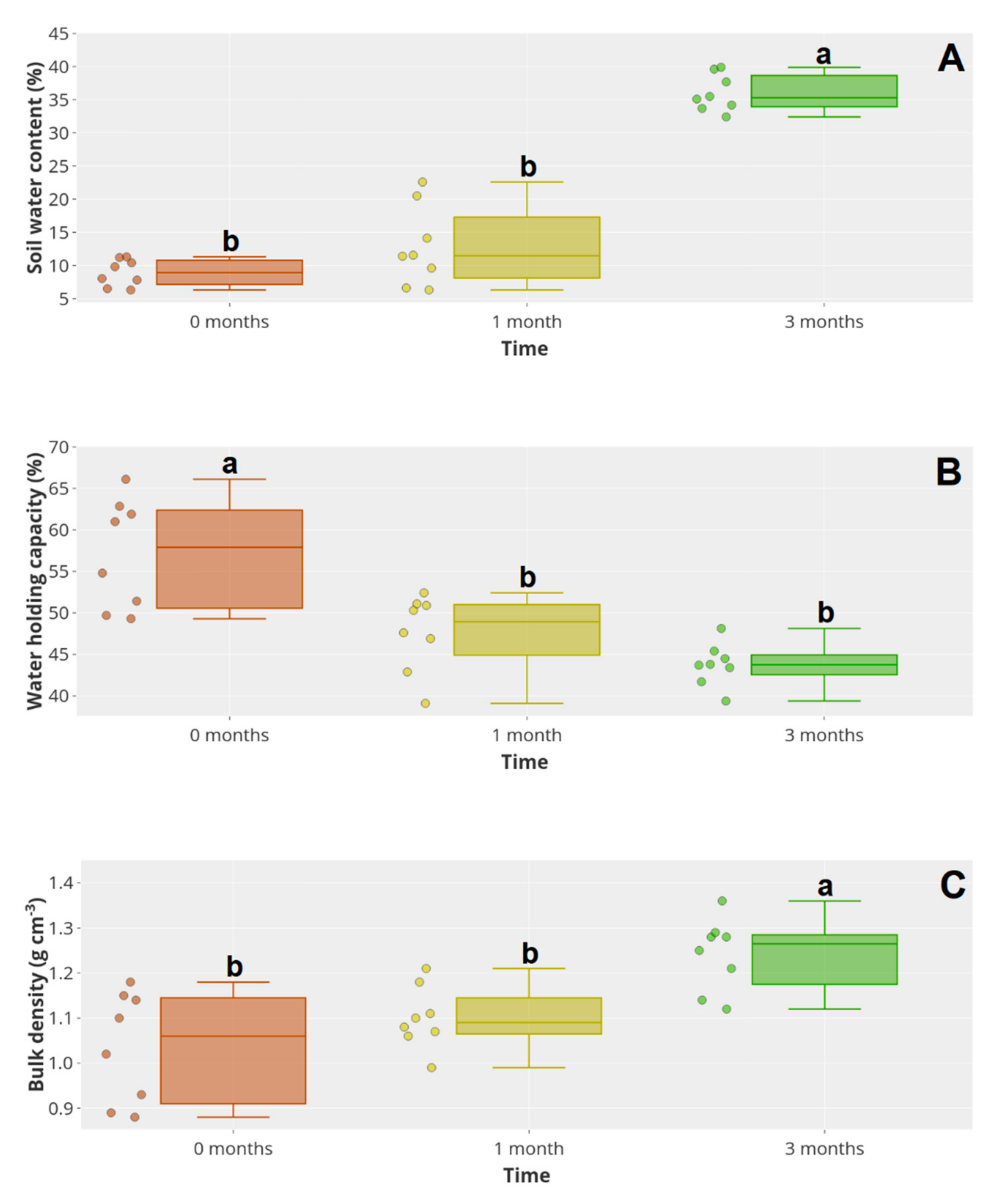
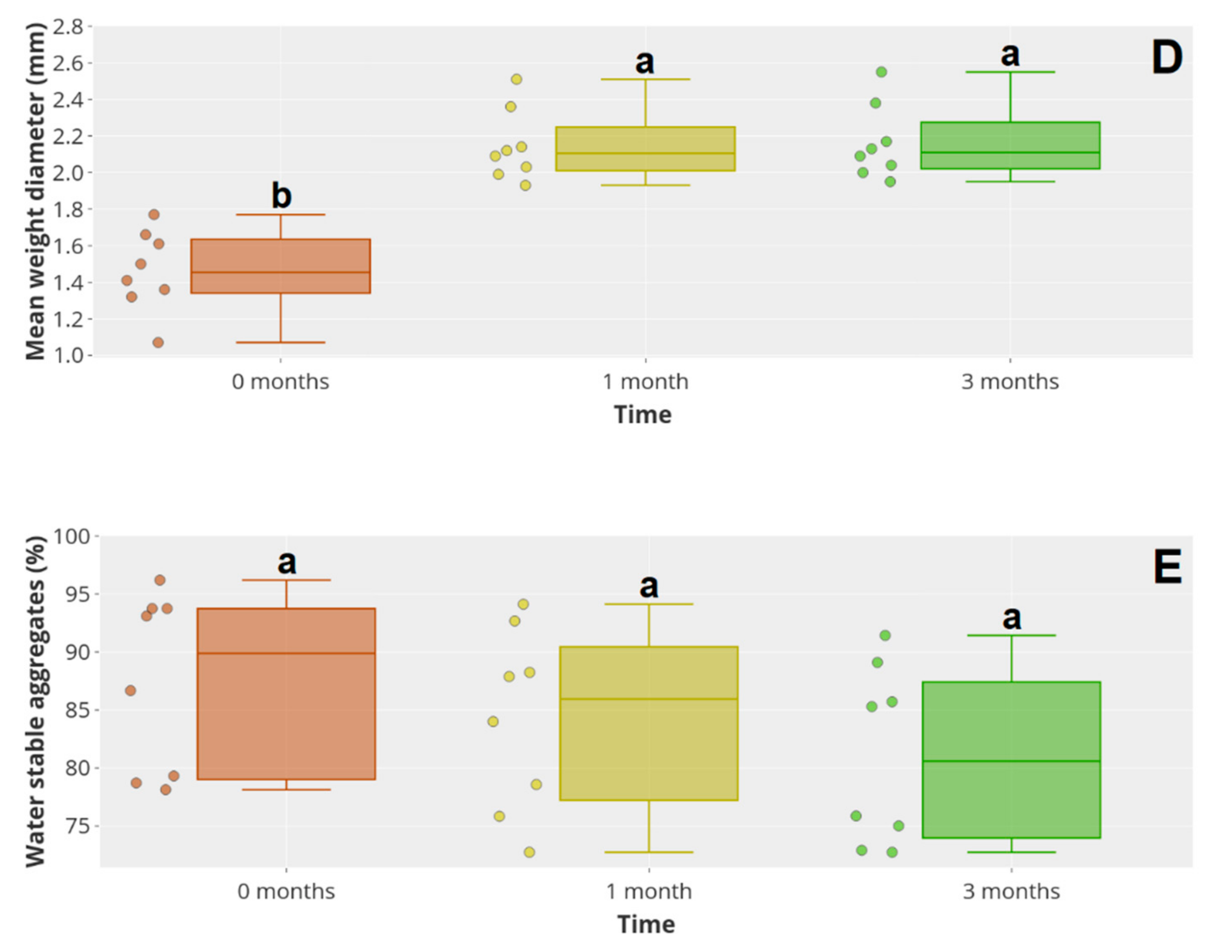
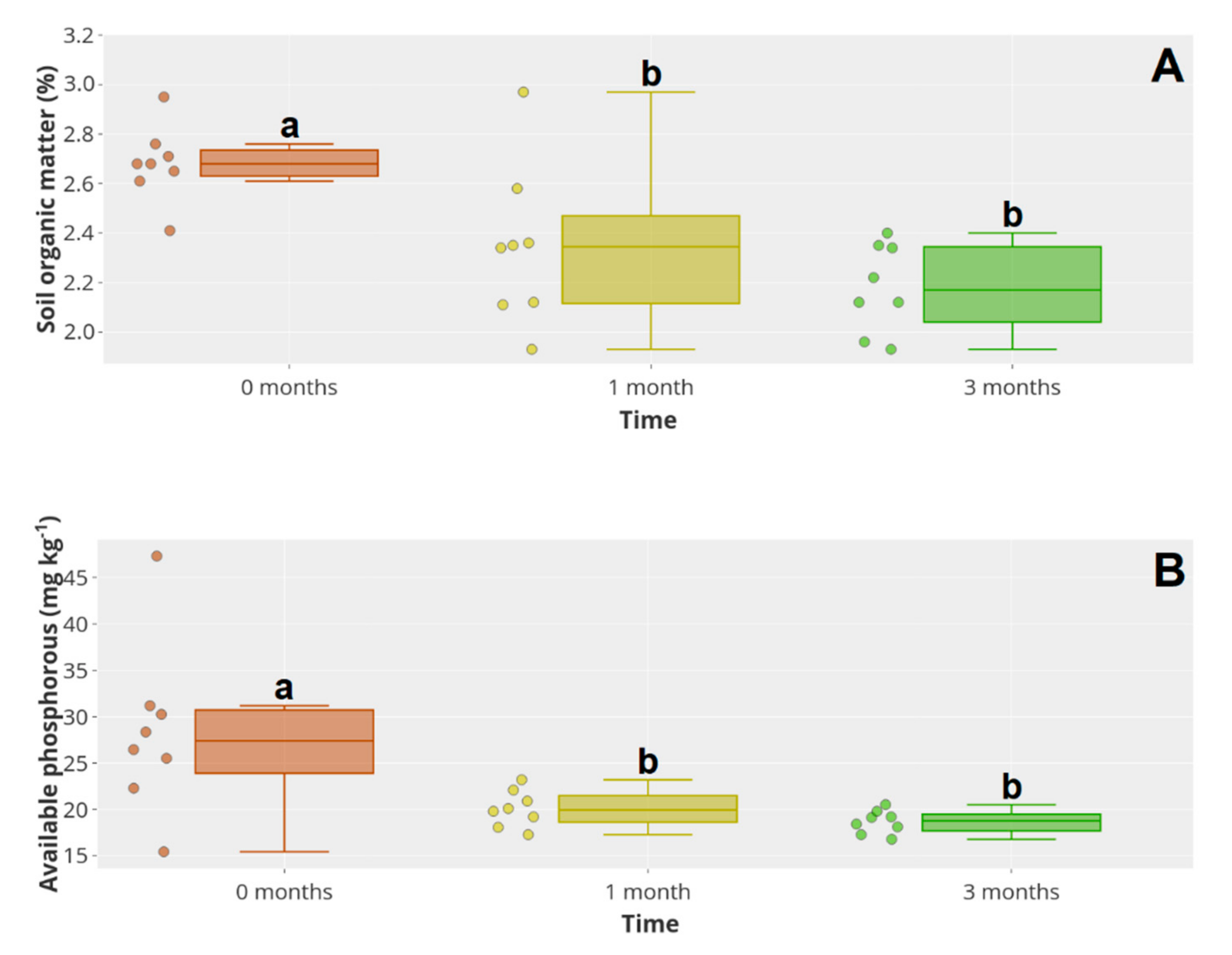
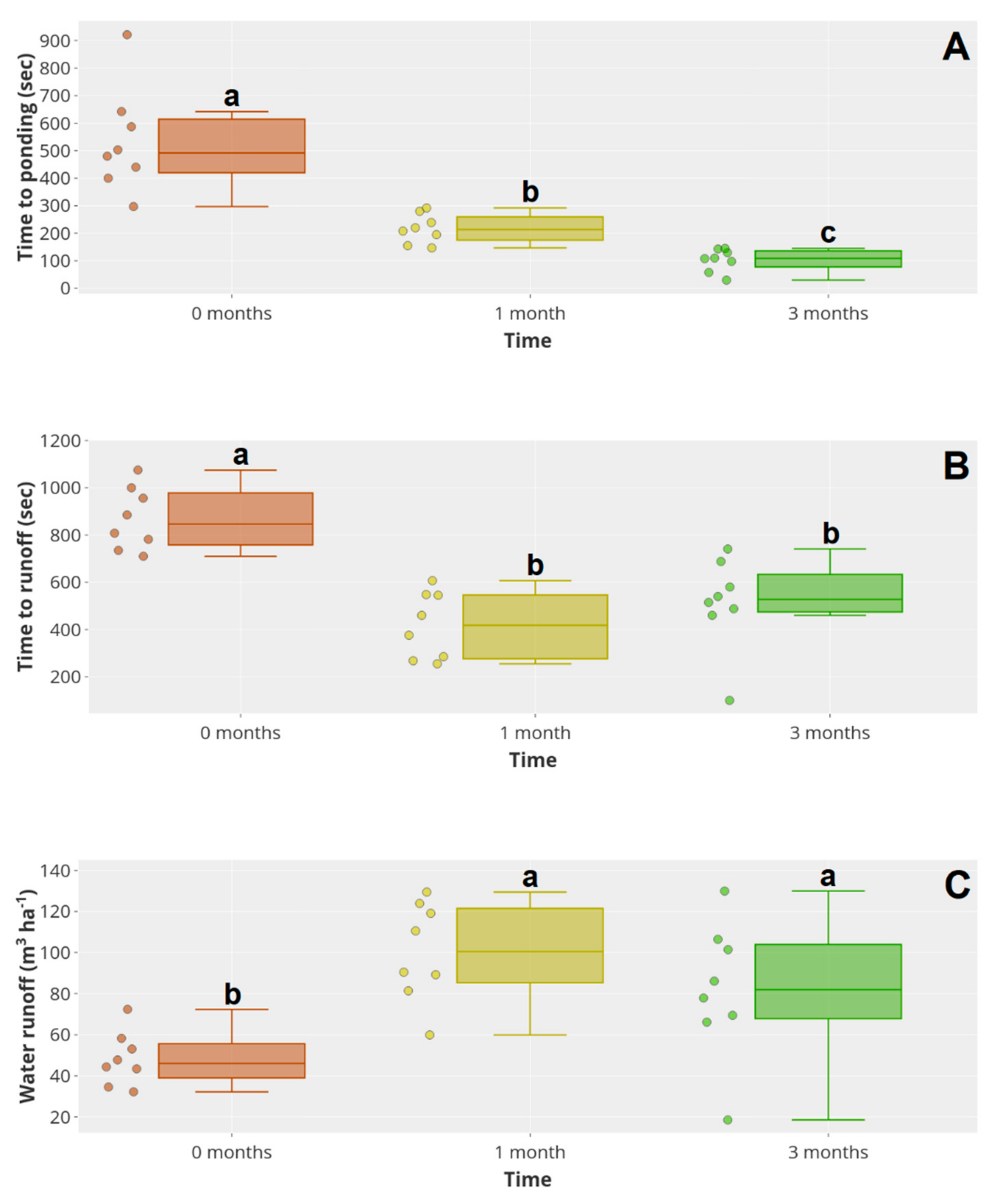
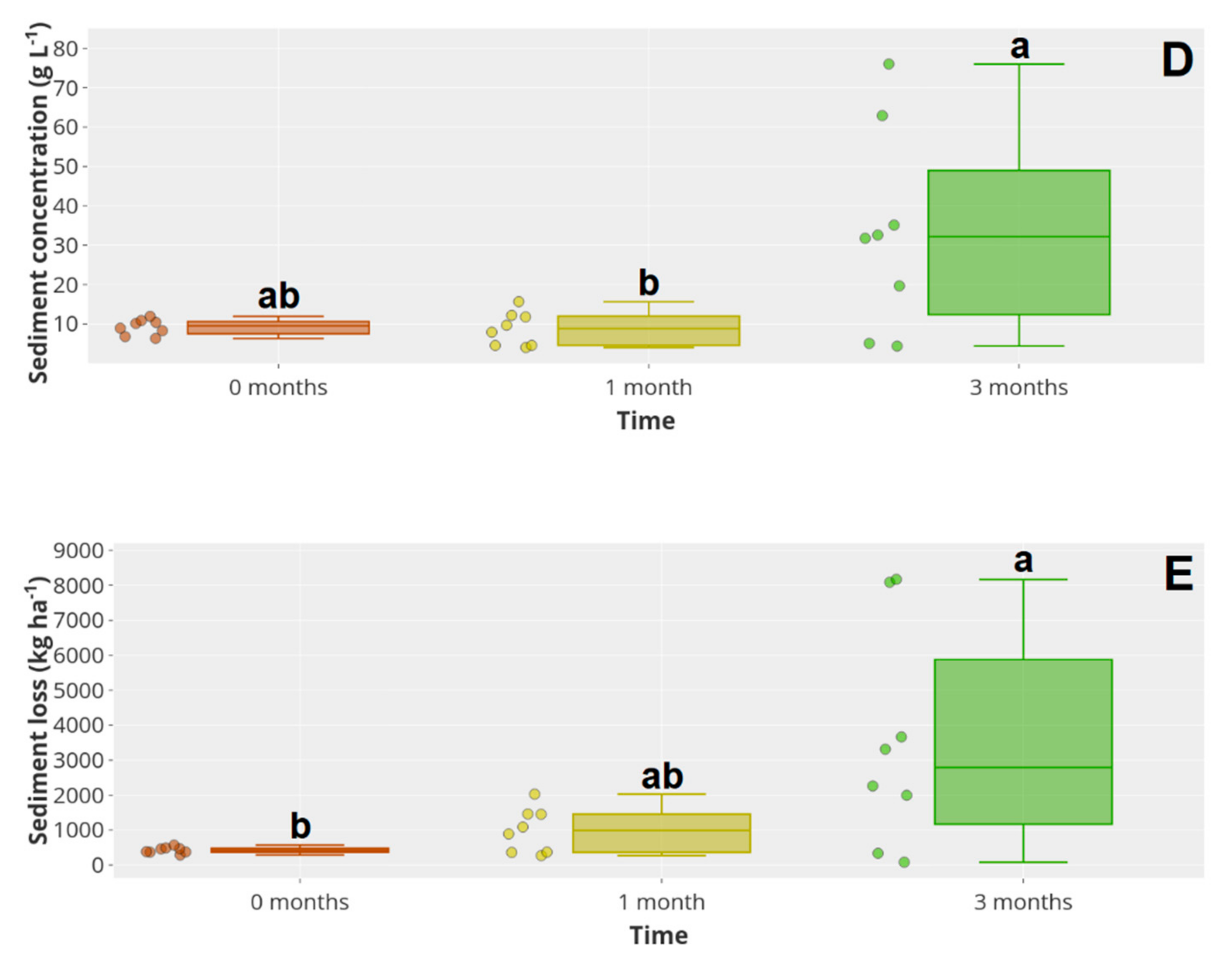
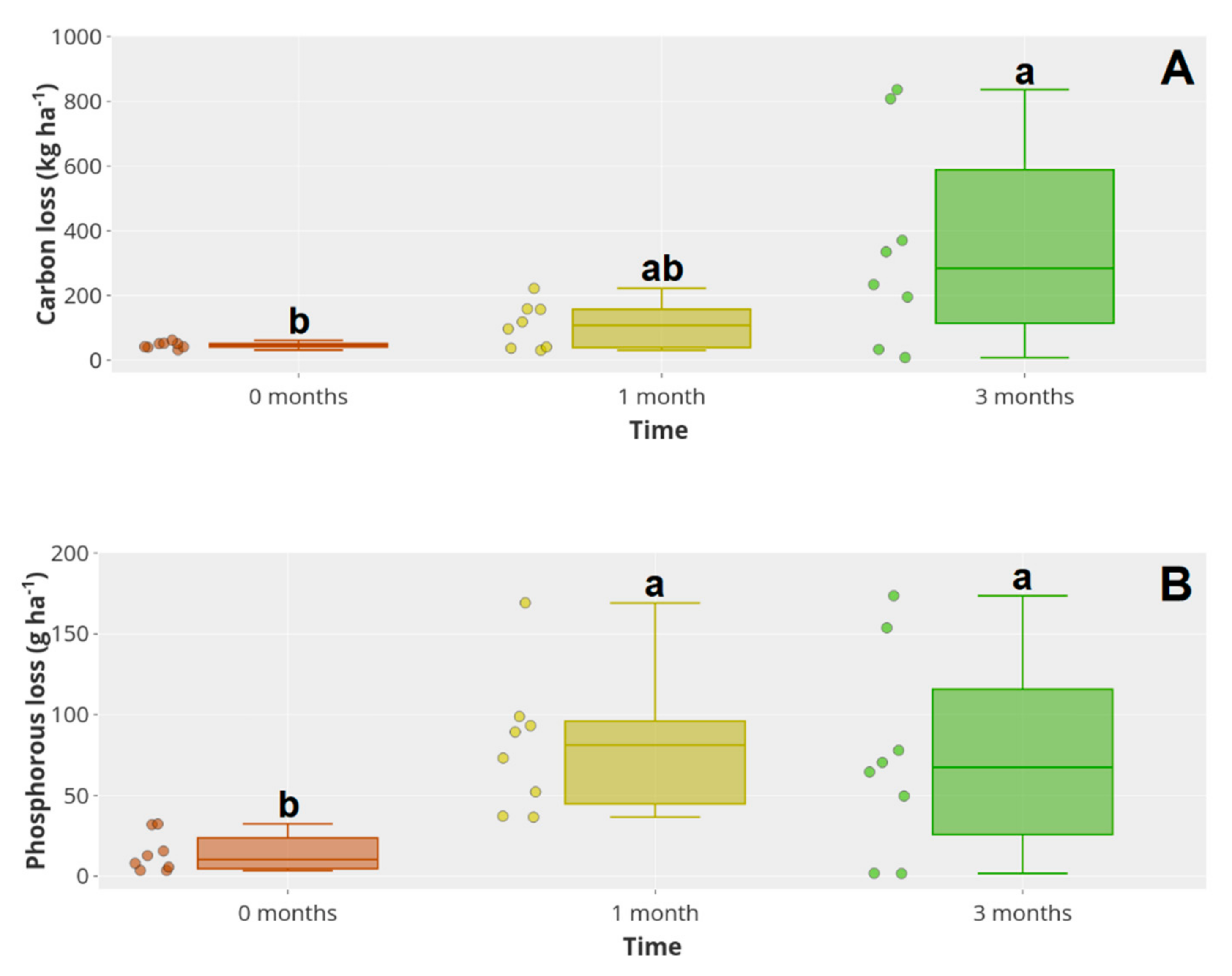
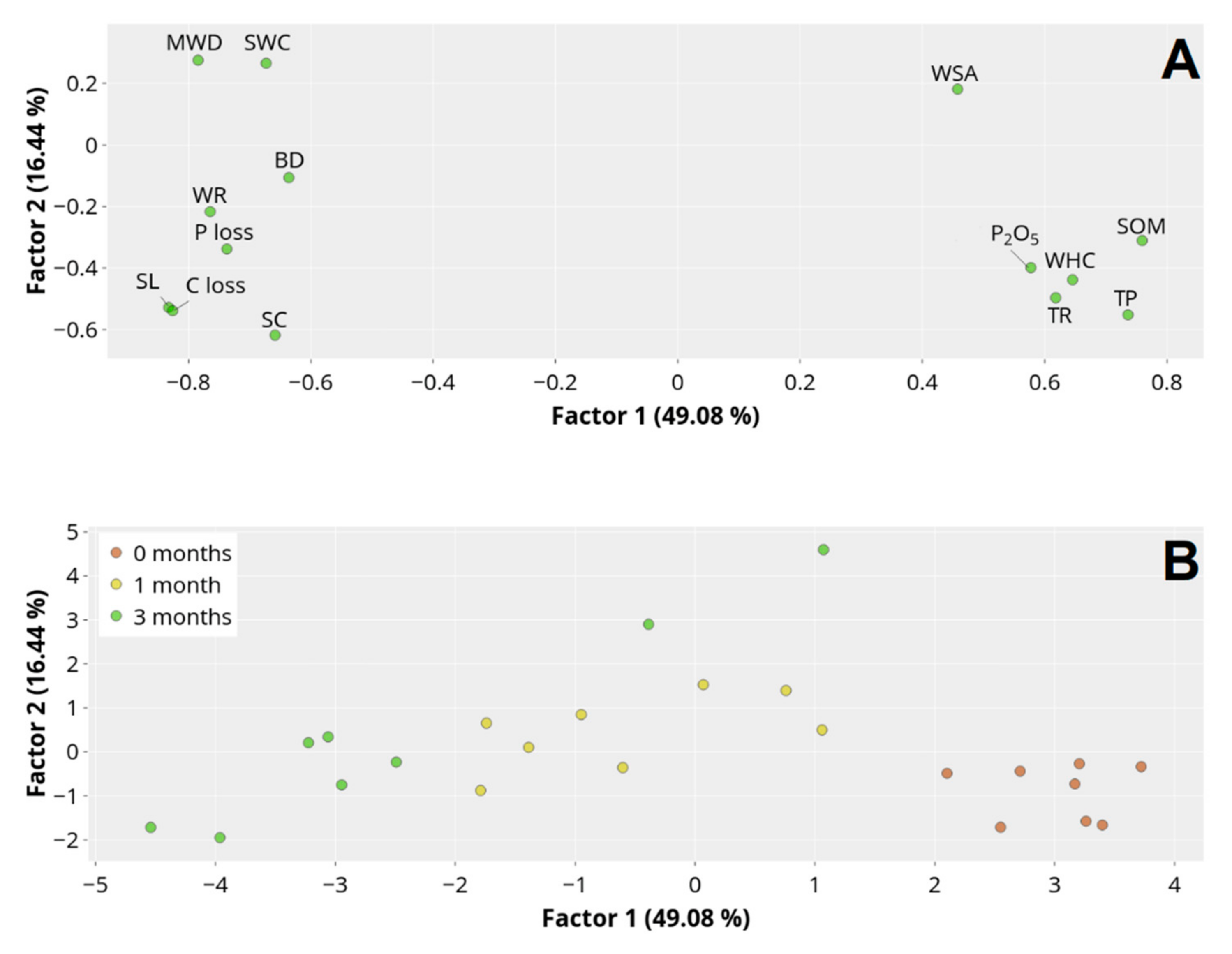
| Properties | Texture (%) | pH | CaCO3 (%) | SOM (%) | Exchangeable Cations (cmol kg−1) | CEC (cmol kg−1) | |||||
|---|---|---|---|---|---|---|---|---|---|---|---|
| Sand | Silt | Clay | Ca | Mg | K | Na | |||||
| Value | 11.6 | 77.2 | 11.2 | 7.52 | 83.45 | 2.68 | 18.91 | 0.70 | 0.30 | 0.25 | 20.16 |
Publisher’s Note: MDPI stays neutral with regard to jurisdictional claims in published maps and institutional affiliations. |
© 2020 by the authors. Licensee MDPI, Basel, Switzerland. This article is an open access article distributed under the terms and conditions of the Creative Commons Attribution (CC BY) license (http://creativecommons.org/licenses/by/4.0/).
Share and Cite
Telak, L.J.; Pereira, P.; Ferreira, C.S.S.; Filipovic, V.; Filipovic, L.; Bogunovic, I. Short-Term Impact of Tillage on Soil and the Hydrological Response within a Fig (Ficus Carica) Orchard in Croatia. Water 2020, 12, 3295. https://doi.org/10.3390/w12113295
Telak LJ, Pereira P, Ferreira CSS, Filipovic V, Filipovic L, Bogunovic I. Short-Term Impact of Tillage on Soil and the Hydrological Response within a Fig (Ficus Carica) Orchard in Croatia. Water. 2020; 12(11):3295. https://doi.org/10.3390/w12113295
Chicago/Turabian StyleTelak, Leon Josip, Paulo Pereira, Carla S. S. Ferreira, Vilim Filipovic, Lana Filipovic, and Igor Bogunovic. 2020. "Short-Term Impact of Tillage on Soil and the Hydrological Response within a Fig (Ficus Carica) Orchard in Croatia" Water 12, no. 11: 3295. https://doi.org/10.3390/w12113295
APA StyleTelak, L. J., Pereira, P., Ferreira, C. S. S., Filipovic, V., Filipovic, L., & Bogunovic, I. (2020). Short-Term Impact of Tillage on Soil and the Hydrological Response within a Fig (Ficus Carica) Orchard in Croatia. Water, 12(11), 3295. https://doi.org/10.3390/w12113295









